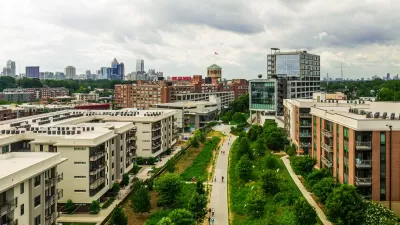With just two miles of an eventual 22 transformed from old rail tracks to trails, Atlantans are enjoying a taste of the planned $2.8 billion BeltLine. Despite its early success, the future of the ambitious project is far from settled.
Plans for the Atlanta BeltLine are certainly bold: the 22 miles of old railroad tracks planned for conversion into parks, housing, and public transit would be the most expensive rails-to-trails project ever completed. "It would add 40 percent more parks to Atlanta. Only 4.6 percent of Atlanta is parkland, compared with 25 percent in New Orleans and 19 percent in New York."
The first phase of the project, the two-mile Eastside Trail, has been popular with joggers, bikers, and commuters - a good sign in this notoriously car-dependent city. And the project has some influential backers, including Mayor Kasim Reed who's proud of the significance of the effort. “We are changing Atlanta into a city that you can enjoy by walking and riding a bike,” said the Mayor. “We have been so car-centric that you didn’t experience the city in an intimate way.”
However, as Robbie Brown reports, "[c]ountless obstacles remain — from purchasing land, digging up decades-old tracks and routing the trail around operating trains and freight yards. But the greatest challenge is financing. The city and a host of nonprofits have raised $350 million through private donations and property taxes on the $2.8 billion project."
"Critics have urged that the project be scaled back. The city’s biggest transit challenge, they argue, is not beautifying in-town neighborhoods but reducing gridlock from the suburbs."
If the boom in construction along the Eastside Trail is any indication, the project's momentum may be enough to drive it forward, despite the critics.
“People want to live in a city where the design makes sense,” said Ryan Gravel, whose graduate thesis sparked the project. “It’s not only changing the physical form of the city. It’s changing the way we think about the city.”
FULL STORY: Now Atlanta Is Turning Old Tracks Green

Planetizen Federal Action Tracker
A weekly monitor of how Trump’s orders and actions are impacting planners and planning in America.

Maui's Vacation Rental Debate Turns Ugly
Verbal attacks, misinformation campaigns and fistfights plague a high-stakes debate to convert thousands of vacation rentals into long-term housing.

San Francisco Suspends Traffic Calming Amidst Record Deaths
Citing “a challenging fiscal landscape,” the city will cease the program on the heels of 42 traffic deaths, including 24 pedestrians.

Amtrak Rolls Out New Orleans to Alabama “Mardi Gras” Train
The new service will operate morning and evening departures between Mobile and New Orleans.

The Subversive Car-Free Guide to Trump's Great American Road Trip
Car-free ways to access Chicagoland’s best tourist attractions.

San Antonio and Austin are Fusing Into one Massive Megaregion
The region spanning the two central Texas cities is growing fast, posing challenges for local infrastructure and water supplies.
Urban Design for Planners 1: Software Tools
This six-course series explores essential urban design concepts using open source software and equips planners with the tools they need to participate fully in the urban design process.
Planning for Universal Design
Learn the tools for implementing Universal Design in planning regulations.
Heyer Gruel & Associates PA
JM Goldson LLC
Custer County Colorado
City of Camden Redevelopment Agency
City of Astoria
Transportation Research & Education Center (TREC) at Portland State University
Jefferson Parish Government
Camden Redevelopment Agency
City of Claremont





























